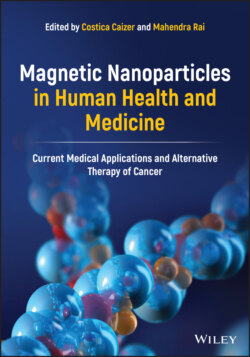Читать книгу Magnetic Nanoparticles in Human Health and Medicine - Группа авторов - Страница 31
2.2.2 Magnetic Particle Imaging (MPI)
ОглавлениеMRI cell‐tracking applications and inflammation response characterization by using MNPs might be replaced soon by a novel emerging technique called Magnetic Particle Imaging (MPI) (Gleich and Weizenecker 2005). As it was stated before, the use of MNPs in MRI does have several drawbacks worth mentioning. Arguably, the most relevant is their rapid elimination from the bloodstream by MPS, hampering their use as more specific targeting agents. The negative contrast they produce is often masking the underlying anatomical tissue structure. Concurrently, the presence of different endogenous sources of contrast such as hemorrhage, air tissue interfaces, and magnetic field imperfections may lead to artefactual images. Because the contrast is produced by the change in the relaxation time of the protons, which in turn is inextricably connected to MNPs concentration, a reliable quantification of their concentration is difficult. Some of these restrictions are eliminated in MPI.
The MPI is based on the principle that MNPs that are magnetized by an external magnetic field can exhibit a nonlinear response in a near‐zero external magnetic field. When the MNPs are placed in an external magnetic field, the magnetization will follow it until a positive or negative saturation value is reached. In a basic MPI scanner setup, the structure of the static magnetic field is such that there is only 1 point in the 3D space where the magnetic field is zero. This point is called “field‐free point” (FFP). When, apart from the static magnetic gradient field, another AC magnetic field (in the range of few kHz) is created, only the MNPs situated in the FFP will follow the oscillations of the AC magnetic field. As such, only these MNPs can induce an electric current in a pick‐up coil. Moreover, due to the nonlinear dependence of the magnetization on the magnetic field strength (which usually is a Langevin function type dependence), the induced current will consist not only in the fundamental frequency of the applied AC magnetic field but also in multiples of the fundamental frequency (harmonics). By measuring the third harmonic, one may separate the contribution of paramagnetic ions or impurities to the induced current. This is possible because the paramagnetic response is linear and contains only the fundamental frequency. Following the spatial reconstruction of the signals recorded in every point, an MP image can be created. In order to reduce the acquisition time, it is possible to create a static field with a “field‐free line” (FFL), but at the cost of resolution. The as‐obtained image represents the spatial distribution of SPIONs since the amplitude of the signal is proportional to the amount of magnetic material, usually expressed in Fe concentration. The foremost advantage is that the recorded signals do not depend on the aggregation state of MNPs, which in most biological applications cannot be neither monitored nor detected. This finding represents the huge advantage of MPI over MRI.
One can consider that MPI is a development of Magnetic Nanoparticle Spectroscopy (MPS) (Wu et al. 2019). This very recent technique can be defined as a zero‐dimensional MPI scanner. Like in MPI, a sinusoidal magnetic field is applied to the SPIONs and their magnetization will be periodically driven in and out of saturation. The nonlinear SPIONs' magnetic response, containing unique spectral information, is recorded and separated into its spectral components. MPS has been actively explored as a portable, highly sensitive, cheap, in vitro, and easy‐to‐use bioassay testing kit. The MPS spectra (including harmonic amplitudes and phases) are unique for each type of SPIONs (Tu et al. 2014). In this manner, by conjugating the SPIONs with specific antibodies, it is possible to label different target analytes (even different cells) with specific types of SPIONs. This feature can be also used in MPI, as we will show later.
